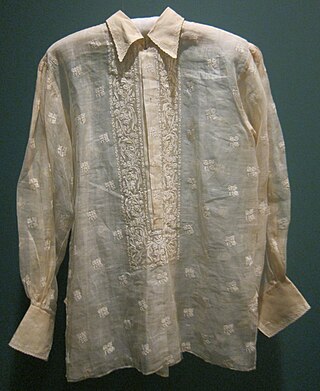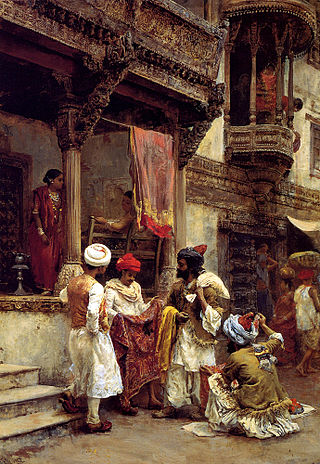Related Research Articles

A kurta is a loose collarless shirt or tunic worn in many regions of South Asia, and now also worn around the world. Tracing its roots to Central Asian nomadic tunics, or upper body garments, of the late-ancient- or early-medieval era, the kurta has evolved stylistically over the centuries, especially in South Asia, as a garment for everyday wear as well as for formal occasions.

The barong tagalog originally known as Camisa Fuera in Spanish, more commonly known simply as barong, is an embroidered long-sleeved formal shirt for men and a national dress of the Philippines. Barong tagalog combines elements from both the precolonial native Filipino and Spanish Philippines clothing styles. It is traditionally made with sheer textiles (nipis) woven from piña or abacá; although in modern times, cheaper materials like organza silk, ramie or polyester are also used.
Longcloth refers to a plain cotton cloth originally made in comparatively long pieces.
The manufacture of textiles is one of the oldest of human technologies. To make textiles, the first requirement is a source of fiber from which a yarn can be made, primarily by spinning. The yarn is processed by knitting or weaving, which turns yarn into cloth. The machine used for weaving is the loom. For decoration, the process of colouring yarn or the finished material is dyeing. For more information of the various steps, see textile manufacturing.

Textile fibers, threads, yarns and fabrics are measured in a multiplicity of units.

Khmer traditional clothing refers to the traditional styles of dress worn by the Khmer people from ancient times to the present.

Shalwar kameez is a traditional combination dress worn by women, and in some regions by men, in South Asia, and Central Asia.

In the ancient Punjab region, people wore cotton clothing. Both men and women wore knee-length tops. A scarf was worn over the tops which would be draped over the left shoulder and under the right. A large sheet would be further draped over one shoulder which would hang loose towards the knees. Both male and female wore a dhoti around the waist. Modern Punjabi dress has retained this outfit but over its long history has added other forms of dress.

Khes is a thin cotton blanket cloth in the Indian subcontinent; it is a damask cloth used for blankets and winter wraps. Khes is generally hand-woven with coarse cotton yarns. Khes as a garment is a simple clothing item to wear loosely to cover the upper body by men in Pakistan and northwest India. Khes is an important cloth in the Punjab region, a region which is famous for its production and historically has been known for not only the production of Khes but also many other coarse cotton textiles, especially in the 19th and 20th centuries. Khes is a comfort object used in bedding, and is also usable as a cover.
Sussi or susi was a term for multicolored striped or checked cloth produced in the Indian subcontinent. Sussi was thin handloom fabric made of cotton, silk, or a blend of the two, with colored warp stripes. Punjab region was known for its production and exports during the Mughal period. Sussi was most often made with red and blue, blue and white, or green and white stripes, but other patterns were also produced. The fabric was exported to England, where sousaes were in great demand in the 18th century.

Piece goods were the textile materials sold in cut pieces as per the buyer's specification. The piece goods were either cut from a fabric roll or produced with a certain length, also called yard goods. Various textiles such as cotton, wool, silk, etc., were traded in terms of piece goods. The prices were determined as per the fabric quality.
Alacha is a lightweight striped cloth made primarily of silk, sometimes cotton, or a mixture of both. The stripe pattern was evident on both sides of the fabric. A typical length of alacha is five yards. It was produced in various parts of India, for example Baikunthpur, Bihar. The cloth was popular in use for female garments such as dupattas (odhni), veils, and petticoats.

Izarband(naada, izārband, Izar band, Kamarband, Kamar Ki Patti and Patka, ازار بند) is a kind of girdle. Izarband is used to tie the upper part of various dresses such as salwar, pajamas, ghagra, petticoat, etc., in the Indian subcontinent. The said garments have the upper side turned inwards and stitched to make a narrow tubular passage, in which the izarband passes, there is one opening in the front side to collect and tie/ knot the ends. Izarband was one of the accessory (closures) items of textiles produced in the Punjab region. The Izarband is similar to a drawstring but narrower than a katzeb or a sash.
Dosuti was one of the coarser cotton piece goods produced in the Indian subcontinent. Originally, it was a handspun and handloom cloth made in the villages. Punjab was having various cotton qualities during the 19th century. All were distinguished with their weight, thickness, and the yarn. Dosuti was a cloth made by running two yarns in warp and weft as its name refers to Do(double) Suti. India's Eastern side was famous for more delicate cotton materials such as Dacca muslins, and Punjab and Gujarat were famous for coarser cotton textile piece goods. Dosuti was a thick cotton material used for rough usages, such as duster. The other contemporary cotton products were Eksuti, Tinsuti, and Chausuti, etc.

Mashru is a woven cloth that is a blend of silk and cotton. It was historically a hand-woven satin silk fabric variety found in the Indian subcontinent, and its proper use is described in the 16th-century Ain-i-Akbari.
Gaji (Gaji cloth) is a coarse cloth made primarily of cotton or silk that is used for native Indian dresses.
Dorea was a type of striped or check patterned cloth made in the Indian subcontinent. The continued striped Dorea was a simplest form of Dorea.
Cottonade was a coarse and heavy cotton cloth usually yarn dyed. There were multiple formations available, including plain, twill, and serge. It was a kind of woolen imitation, and the strong variants were used for men's trousers. Twill structured blue and white striped men's workwear with hickory cloth-like appearance was used. Cottonade was initially used for less expensive men's clothing, it was eventually supplanted by superior materials such as "cassimeres", which became fashionable.
Sangi was a kind of silk produced in Hindustan. It was a mixed woven cloth, a common cloth in the nineteenth century. The fabric was constructed with a cotton warp and a silk weft, or vice versa.
Ghalta was an old Hindustani fabric made of silk and cotton. Additionally, it was given the name " Azamgarh Satinette." According to John Shakespear, Ghalta was also referred to "a thick sort of cloth."
References
- ↑ Report on the Administration of the Punjab and Its Dependencies. 1872. p. 164.
- ↑ A Monograph on Silk Fabrics Produced in the Northwestern Provinces and Oudh. Printed at the N.-W. Provinces and Oudh Government Press. 1900. p. 90.
- ↑ Habib, Irfan (2003). "Textile Terms in Medieval Indian Persian Texts: A Glossary". Proceedings of the Indian History Congress. 64: 525–547. ISSN 2249-1937. JSTOR 44145489.
- ↑ Gazetteer of the Ferozpur District: 1883. 1883. p. 77.
- ↑ Birdwood, George Christopher Molesworth (1878). Paris Universal Exhibition of 1878: Handbook to the British Indian Section. Royal Commission. p. 101.
- 1 2 Baluchistan (Pakistan) (1907). Baluchistan District Gazetteer Series. Vol. 6. p. 222 – via Google books.
Sohrén gulbadan is made in pieces 36 feet long by 1 foot 4 inches wide . The ground is scarlet with thin yellow and green lines . It is made either of silk or cotton , and is in common use for shirts and trousers among the women of all classes
- 1 2 An Anthropological Reconnaissance in West Pakistan, 1955. 1954. p. 71 – via Google books.
These are often of dark green crepe with a red border . c ) Sohren gulbadan is made in silk or cotton pieces ( 36 feet x 16 inches ) . The material is scarlet with thin yellow lines . This material is used for shirts and trousers among all classes of
- ↑ Official Report of the Calcutta International Exhibition, 1883-84: Compiled Under the Orders of the Executive Committee. Bengal Secretariat Press. 1885. p. 449.
- 1 2 Tortora, Phyllis G.; Johnson, Ingrid (2013-09-17). The Fairchild Books Dictionary of Textiles. A&C Black. p. 275. ISBN 978-1-60901-535-0.